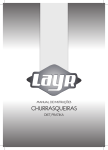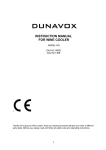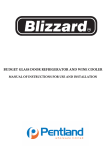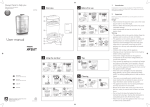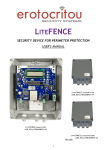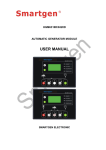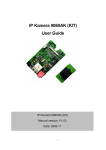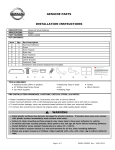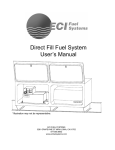Download SOP: Operating a pressure cooker and autoclave
Transcript
STANDARD OPERATING PROCEDURE: Operating a pressure cooker and autoclave Note: To be undertaken only by trained personnel in conjunction with a site-specific risk assessment and the manufacturer’s instructions. ___________________ 1. Introduction A pressure cooker, pressure steam steriliser or an autoclave is commonly used in the laboratory to effectively sterilise micro-organisms and agar. Pressure steam sterilisers and autoclaves reach the recommended temperature and pressure required to render most microorganisms and agar sterile. 2. Context These instructions are for the use of experienced science teachers and technicians only. These guidelines are general and the manufacturer’s user manual should always be consulted for the particular equipment in use. 3. Safety notes Very hot surfaces – use a sign where appropriate to indicate hot surfaces. Steam – burns and scalds hazard; always open pressure cooker lid away from face. Very hot liquids. Heavy equipment. High pressure; only open pressure cooker when cooled and the pressure is down to zero. Must be stored and operated in the science preparation room or dedicated microbiology preparation area only away from students. Do not leave pressure cookers unattended during use. 4. Regulations, licences and permits Pressure cooker To maintain sterilization at 1210C for 15–20 minutes at 15p.s.i (pounds per square inch), the following considerations must be given when purchasing a pressure cooker. Ensure the pressure cooker is an adequate size to sterilise agar in bottles. The pressure cooker must contain a pressure gauge and be able to reach a pressure of 15p.s.i. (103kPa) and a temperature of 1210C. Note that some domestic cookers do not meet these requirements. Autoclave An autoclave manufacturer or supplier will advise you on the appropriate autoclave type for your purpose. Ensure the autoclave manufacturer has preset programmes for your specific sterilising needs and provides metal racks and/or baskets for sterilising small items. Version 1.0 SOP: Operating a pressure cooker and autoclave Written by: Science ASSIST Disclaimer: ASTA excludes all liability to any person arising directly or indirectly from using this resource. Date: June 2015 Page 1 of 5 5. Equipment Pressure cooker or autoclave Oven bags for pressure cooker or autoclave bags Chemical sterility indicator strips in the form of paper or cardboard strips. The use of autoclave tape is an indication that an article has gone through a heating process but should not be relied upon as a control of sterilisation PPE, including heat proof gloves, safety glasses or face shield Distilled water Heat source or power supply for pressure cooker Power supply for autoclave Glassware that is heat resistant borosilicate. Bottles should have appropriate heat resistant lids and glass conical flasks plugged with non-absorbent cotton wool 6. Operating procedure General notes for pressure cooker and autoclave use Preparation of articles to be sterilised. Check that materials and equipment are able to withstand high temperatures and pressure. Inspect glassware for chips or cracks. Conical flasks or bottles of agar should be filled to no more than 2/3, plugged with nonabsorbent cotton wool plugs covered loosely with aluminium foil or greaseproof paper to prevent the plug from becoming wet. Lids on bottles should be loosened by ¼ turn. Forceps and other instruments should be wrapped loosely in aluminium foil or greaseproof paper (optionally wrapped in foil) to permit the penetration of steam into the pack. Use only autoclavable test tube racks. To allow for steam penetration, autoclave bags must not be tightly packed or sealed, nor should they be reopened. Place chemical sterility indicator strips in the centre of every load. Check the strip after the run is complete to ensure temperature and steam conditions have been met. Autoclaving is not recommended for radioactive wastes because of the potential for contaminating equipment and generating radioactive vapours. You should also never autoclave solvents, volatile or corrosive chemicals. Oils are usually sterilised by dry heat. Do not use a pressure cooker in an oven. Only use distilled water (if available) in the autoclave or pressure cooker. Tap water contains minerals that build-up in the unit and will need to be removed regularly. Do not stack or store combustible material next to an autoclave (cardboard, plastic, volatile or flammable liquids). Do not attempt to open the lid or door while pressure cooker or autoclave is operating. After sterilisation, make sure the pressure is down to zero before opening either the pressure cooker or autoclave. Avoid touching the inner chamber surfaces. Qualified persons should only perform repair and servicing of pressure cookers or autoclaves. Operating procedure continued….. Version 1.0 SOP: Operating a pressure cooker and autoclave Written by: Science ASSIST Disclaimer: ASTA excludes all liability to any person arising directly or indirectly from using this resource. Date: June 2015 Page 2 of 5 For spilled material clean up. 1. Review the Safety Data Sheet (if appropriate) to determine the protective equipment, spill cleanup and disposal protocols that are necessary. 2. Wait until the pressure cooker or autoclave and articles have cooled to room temperature. 3. Contain any spilled material using paper towel to absorb or contain the spill. 4. Clean the equipment and work area in order to collect and remove all spilled materials. 5. Dispose of the waste following the protocol appropriate for the material. If materials have been intermingled, follow the cleanup and disposal protocol for the most hazardous component of the mixture Pressure cooker operation 1. Inspect the vent pipe and holes in the vent nut of the lid, the black rubber over pressure plug and the sealing ring before using each time. 2. Place the cooker on a level heatproof surface, over a heat source or close to a power point. 3. Add approximately 2cm of distilled water to the base of the cooker to cover the support dish. Ensure that the support dish and internal heating element (if applicable) are covered. 4. Place prepared articles to be sterilised on the support stand in the cooker—do not exceed manufacturers recommended load capacity, generally 2/3 full. Ensure there is space around items for the steam to circulate. 5. Grease the point of contact between the lid and the base with silicone grease before each use to ensure a good seal. 6. Place the lid on the cooker and ensure it is locked into position and tightly sealed. Commence heating the cooker by warming on the medium to high heat setting. Check the control valve is in the open position initially, to allow the release of steam to exhaust the air that is trapped in the cooker. When the air has been exhausted, close the control valve. If your pressure cooker has a pressure regulator weight, allow the steam to vent prior to putting on the regulator weight. Depending on the brand of cooker, the plunger will rise or a needle on the pressure gauge will move to indicate the rise in pressure. The lid will now remain locked while the cooker is under pressure. 7. The correct pressure has been reached when the pressure regulator begins to rock, or the pressure gauge reaches the green sterilisation zone. Sterilisation time can now commence. Maintain the temperature at 1210C for 15–20 minutes. 8. When sterilisation time is complete, turn the pressure cooer off and allow the pressure to reduce. The lid can be removed when the pressure has dropped to zero. Do not cool the cooker under cold water. Wear heatproof gloves and safety glasses or face shield to slowly remove the lid locking devices. 9. Remove and check the chemical indicator strip according to manufacturer’s instructions. When sterilisation has been established, remove sterilised material. Waste material should be double bagged and placed in the general waste bin. 10. Remove all water from the steriliser prior to storing. Do not leave water in the steriliser overnight. Store in a dry area. Operating procedure continued….. Version 1.0 SOP: Operating a pressure cooker and autoclave Written by: Science ASSIST Disclaimer: ASTA excludes all liability to any person arising directly or indirectly from using this resource. Date: June 2015 Page 3 of 5 Autoclave operation 1. Check autoclave water volume. Use distilled water to fill. Check that the door seal is not compromised, the drain seal at the bottom of the chamber is clear of debris, and ensure the waste bottle is empty. 2. Insert metal trays into the chamber. 3. Add prepared articles to be autoclaved, ensuring the load does not exceed manufacturer’s recommendations and steam is able to freely circulate around the articles. 4. Turn the autoclave power on and close the door, ensuring the door is sealed. 5. Set the temperature to 1210C, pressure at 15p.s.i. (pounds per square inch) for 15– 20 minutes. Start the cycle. 6. When the cycle is complete, an alarm will sound. If fitted, turn the autoclave to vent. The door should not be opened until the pressure has reduced to zero. If a drying stage is provided, a drying process is activated and operates until the load is dry. 7. Allow sterilised material to stand for 10 minutes in the chamber. This will allow steam to clear and trapped air to escape from hot liquids, reducing risk to operator. 8. Stand back from the door as a precaution, carefully open door to no more than 2.5 cm to release residual steam and allow pressure within liquids and containers to normalise. Do not agitate containers of super-heated liquids or remove caps before unloading. 9. Remove and check the chemical indicator strip according to manufacturer’s instructions. When sterilisation has been established, remove autoclaved articles with heatproof gloves and wear safety glasses or a face shield. 10. After removal from the autoclave, place hot items in an area which clearly indicates the items are 'hot' until the items cool to room temperature. 11. Record in a log book the date, duration and operator for each time the autoclave is run. 12. Trained service personnel should carry out monitoring and validation according to the manufacturer’s instructions at 12-month intervals. 7. Trouble shooting/emergencies First aid: o Burns and scalds: If clothing is soaked in hot water/steam, remove clothing and any jewellery and cool the injured body area under running cool water for at least 20 minutes. Cover the area with a clean, non-adhesive dressing and seek medical attention for a burns assessment. o In case of biological exposure, wash skin with soap and water. 8. Waste disposal It should be noted that pressure cookers and autoclaves are used for sterilising and do not produce waste as such, but all microbial waste materials should be sterilised and double bagged before disposing in the regular waste. Sterilised inoculated agar plates should be disposed of in the unopened sterilising bag. Double bag and place into general waste. Version 1.0 SOP: Operating a pressure cooker and autoclave Written by: Science ASSIST Disclaimer: ASTA excludes all liability to any person arising directly or indirectly from using this resource. Date: June 2015 Page 4 of 5 Unused sterilised agar should be allowed to set, and then double bagged and then placed in general waste. Do not allow agar to set in drains. 9. Related material Manufacturers instruction manual Risk assessment SDS for materials to be sterilised and the products produced. References: Centre for Healthcare Related Infection Surveillance and Prevention 2008. Disinfection and Sterilization Control Guidelines. Section 4 Quality Management in Sterilization Queensland Department of Health website http://www.health.qld.gov.au/chrisp/sterilising/section_4.pdf ‘E8.015 – Steroclave, 15L. non-electric, 31cm base diametre’ Southern Biological websitehttp://www.southernbiological.com/kits-and-equipment/microbiology-equipment-andsupplies/sterilisers/e8-015-steroclave-15l-non-electric-31cm-base-diameter/ (Accessed June 2015) ‘Pressure Cooker Instruction Manuals’ Pressure Cooker Centre website, http://www.pressurecooker.com.au/Pressure-Cooker-Instruction-Manuals (Accessed June 2015) Siltex Australia Pty Ltd 2009. Pratika B/Pratika S quick reference guide. Siltex (Australia) East Bentleigh, Victoria. St John Ambulance 2010. Australian First Aid Manual St John Ambulance: Barton, ACT. Version 1.0 SOP: Operating a pressure cooker and autoclave Written by: Science ASSIST Disclaimer: ASTA excludes all liability to any person arising directly or indirectly from using this resource. Date: June 2015 Page 5 of 5







